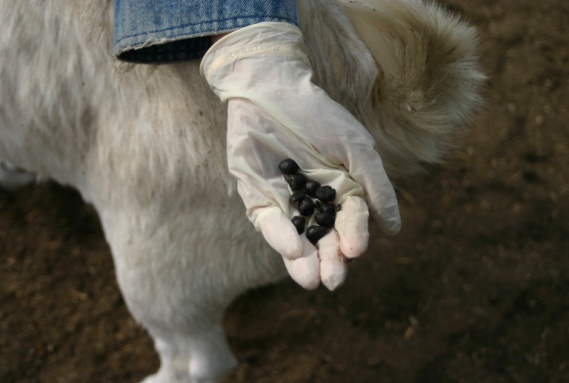NAHMS-457 NAHMS Goat 2019 Post-Deworming (Kit B) Collection Record
National Animal Health Monitoring System; Goat 2019 Study
NAHMS 457 JUN 2019
Goat 2019 Study - Respondents
OMB: 0579-0354
NAHMS
Goat 2019
Post-deworming
(Kit B)
Collection
Record
National
Animal Health Monitoring System
2150
Centre Ave, Bldg B
Fort
Collins, CO 80526
Form
Approved
OMB
Number 0579-0354
Approval
expires:



Animal and Plant
Health Inspection
Service
Veterinary
Services
Kit contents:
25 gloves, 25 small Whirl-Pak® bags, lubricant, 2 ice packs, 1 liner bag, 1 medium insulated cooler, and paperwork that includes submission form, labels, and UPS airbill addressed to LSU in Baton Rouge, LA.
Collection Instructions
1. Collect the post-deworming fecal samples Sunday-Wednesday, 10-14 days after deworming. Select the same goats that were sampled previously, which are listed on the pre-deworming form. From each goat, collect 5-6 fecal pellets. Use clean gloves for each goat. Collect samples from the rectum when possible. Be sure to use lubricant and be careful not to damage the rectum. Rectal retrieval might not be possible on some goats (e.g. preweaned kids), and fresh off the ground samples are acceptable. On each label, write the goat’s name or ID, and attach the label to the sample bag.
2. Samples must be fresh (not petrified). Do not exclude diarrhea samples. Goats sampled should match the goats on the pre-deworming form.
3. Cool samples down as soon as possible (in a refrigerator or cooler).
RECTAL RETRIEVAL To avoid contamination from common organisms on the ground, rectal retrieval is best. Rectal retrieval might not be possible on some goats (e.g. preweaned kids), and fresh off the ground samples are acceptable. |
|||
|
1. Apply lubricating jelly to the glove before entering the rectum.
|
|
2. Retrieve a minimum of 5-6 pellets per animal.
|
|
|
|
|
3. Place pellets in a Whirl-Pak® bag. On each label, write the goat’s name or ID and attach it on to the bag. 4. Continue collecting samples from other goats using a clean glove for each. |
|||
According
to the Paperwork Reduction Act of 1995, an agency may not conduct or
sponsor, and a person is not required to respond to, a collection of
information unless it displays a valid OMB control number. The valid
OMB control number for this information collection is 0579-0354. The
time required to complete this information collection is estimated
to average 2.0 hours per response, including the time for reviewing
instructions, searching existing data sources, gathering and
maintaining the data needed, and completing and reviewing the
collection of information.


NAHMS-457JUN
2019
Collection Record Form Instructions
Using a ballpoint pen, record samples on the appropriate lines and complete all information requested. Refer to the yellow pre-deworming collection form, and list the goat name or ID in the same order.
Send the white copy to the lab. The yellow copy stays with you, the producer, for your records.
Shipping Instructions
1. Ship on Monday-Wednesday. Keep samples cool (refrigerate samples) and ship within 24 hours of collection. Wednesday collections must be shipped the same day.
2. Place all the samples in the liner bag and tie shut. Place an ice pack on the top and bottom of the samples. Add filler to box if necessary. Close the insulated cooler box and place the white collection record on top of the cooler box lid. The yellow copy stays with you, the Producer.
Secure the box and ship to LSU, in Baton Rouge, LA, within 24 hours. A shipping airbill is provided in the kit. Ship only Monday-Wednesday.
NOTE: Remove or black out all extraneous labels on outside of box.
Sample # (same as Kit A) |
Goat name or ID (same as Kit A) |
Age
(months
|
Goat Type
1= pregnant doe 2=nursing doe 3=preweaned kid 4=weaned kid 5=open doe 6=buck 7=wether |
Conditions in past 30 days
1=Diarrhea 2=Weight loss 3=Poor hair coat 4=Anemic (based on FAMACHA) 5=Other (specify)
[list all that apply] |
Grazing History*
1= Previous 30 days, grazing at all times 2= Previous 30 days, grazing periodically 3=No grazing in previous 30 days, but grazing in prior 12 months 4= No grazing in previous 12 months |
Browsing History**
1= Previous 30 days, browsing at all times 2= Previous 30 days, browsing periodically 3=No browsing in previous 30 days, but browsing in prior 12 months 4= No browsing in previous 12 months |
1 |
|
___ mo OR ___ yr |
|
|
|
|
2 |
|
___ mo OR ___ yr |
|
|
|
|
3 |
|
___ mo OR ___ yr |
|
|
|
|
4 |
|
___ mo OR ___ yr |
|
|
|
|
5 |
|
___ mo OR ___ yr |
|
|
|
|
6 |
|
___ mo OR ___ yr |
|
|
|
|
7 |
|
___ mo OR ___ yr |
|
|
|
|
8 |
|
___ mo OR ___ yr |
|
|
|
|
9 |
|
___ mo OR ___ yr |
|
|
|
|
10 |
|
___ mo OR ___ yr |
|
|
|
|
Sample # (same as Kit A) |
Goat name or ID (same as Kit A) |
Age
(months
|
Goat Type
1= pregnant doe 2=nursing doe 3=preweaned kid 4=weaned kid 5=open doe 6=buck 7=wether |
Conditions in past 30 days
1=Diarrhea 2=Weight loss 3=Poor hair coat 4=Anemic (based on FAMACHA) 5=Other (specify)
[list all that apply] |
Grazing History*
1= Previous 30 days, grazing at all times 2= Previous 30 days, grazing periodically 3=No grazing in previous 30 days, but grazing in prior 12 months 4= No grazing in previous 12 months |
Browsing History**
1= Previous 30 days, browsing at all times 2= Previous 30 days, browsing periodically 3=No browsing in previous 30 days, but browsing in prior 12 months 4= No browsing in previous 12 months |
11 |
|
___ mo OR ___ yr |
|
|
|
|
12 |
|
___ mo OR ___ yr |
|
|
|
|
13 |
|
___ mo OR ___ yr |
|
|
|
|
14 |
|
___ mo OR ___ yr |
|
|
|
|
15 |
|
___ mo OR ___ yr |
|
|
|
|
16 |
|
___ mo OR ___ yr |
|
|
|
|
17 |
|
___ mo OR ___ yr |
|
|
|
|
18 |
|
___ mo OR ___ yr |
|
|
|
|
19 |
|
___ mo OR ___ yr |
|
|
|
|
20 |
|
___ mo OR ___ yr |
|
|
|
|
Sample # (same as Kit A) |
Goat name or ID (same as Kit A) |
Age
(months
|
Goat Type
1= pregnant doe 2=nursing doe 3=preweaned kid 4=weaned kid 5=open doe 6=buck 7=wether |
Conditions in past 30 days
1=Diarrhea 2=Weight loss 3=Poor hair coat 4=Anemic (based on FAMACHA) 5=Other (specify)
[list all that apply] |
Grazing History*
1= Previous 30 days, grazing at all times 2= Previous 30 days, grazing periodically 3=No grazing in previous 30 days, but grazing in prior 12 months 4= No grazing in previous 12 months |
Browsing History**
1= Previous 30 days, browsing at all times 2= Previous 30 days, browsing periodically 3=No browsing in previous 30 days, but browsing in prior 12 months 4= No browsing in previous 12 months |
21 |
|
___ mo OR ___ yr |
|
|
|
|
22 |
|
___ mo OR ___ yr |
|
|
|
|
23 |
|
___ mo OR ___ yr |
|
|
|
|
24 |
|
___ mo OR ___ yr |
|
|
|
|
25 |
|
___ mo OR ___ yr |
|
|
|
|
| File Type | application/vnd.openxmlformats-officedocument.wordprocessingml.document |
| File Modified | 0000-00-00 |
| File Created | 2021-01-15 |
© 2025 OMB.report | Privacy Policy

